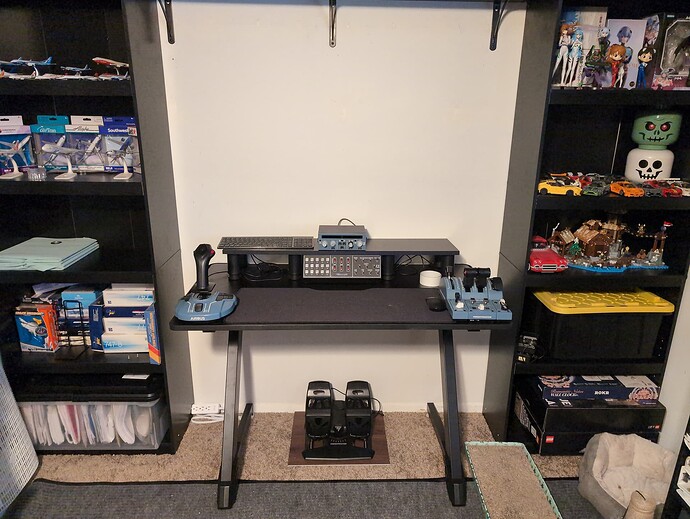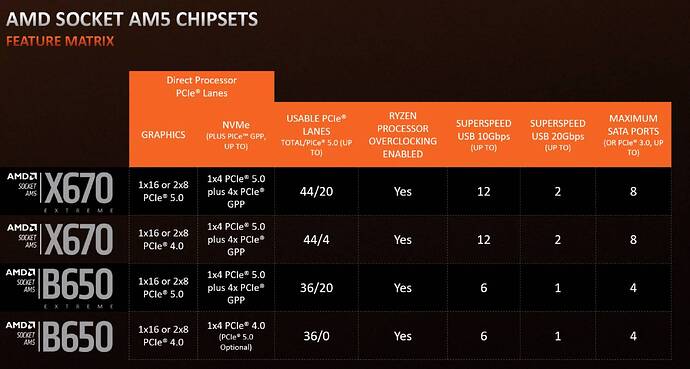AMD Build rev.2
With some of the suggestions I have changed out the GPU to the powercolor hellhound (turning off the LED is a plus), Lian Li 216 (not sure if I wanna do RGB fans or not), and I checked the QVL for the RAM.
On the RAM, I did find one listed under QVL but am wondering if like with the AM4 platform, XMP ram worked with DOCP on my motherboard to clock the RAM. But with this kit being XMP will it work with EXPO (is that the same as DOCP under a different name?).
Haha it’s awesome when games sync up with lighting effects. It was really cool with Diablo 4 and a few other games I played.
Also for fun this is the space wifey gave me… in the office closet haha
Yes, XMP will work just fine, especially if it is on the QVL. My DDR5-7200 ram is XMP and worked on 1st boot.
Edit: doesn’t have to be EXPO memory - XMP will also work. Just go with the QVL and you’re good.
1 Like
Looks like a solid system. The only thing you may (and just a tiny nit pick) want to think about is if you’ll want to make use of PCIe 5.0 before your next mobo upgrade. The B650 chipset does not have PCIe 5.0 lanes, but the B650E, X670, and X670E chipsets do offer that compatibility. The number of 5.0 lanes will vary depending on the chipset as well. It’s not really a concern right now, but I’m guessing we’ll start seeing top end GPU’s start to benefit from 5.0 in the next generation or two.
2 Likes
Great point! In addition we are starting to see PCIe 5 NVMe drives already.
1 Like
True, but I think we are much farther from seeing real benefits from them. I think they also run a fair bit hotter than gen 4 and below drives.
I like some of the designs of both Asus and MSI, but I lean towards MSI and it’s what I currently have with my 5800x3d. Plus, they have a “Kombo Strike” feature in their BIOS, which can sometimes help get extra performance from x3d chips beyond what the PBO voltage offsets can do (a happy surprise I found out after I installed mine). I can’t say it’ll work across the board for all users, and there are certainly ones that claim no benefit for them. MSI’s scandal a while back was basically buying reviews and helping scalpers during the GPU shortages.
With Asus, their latest scandals have been more on board reliability issues and not wanting to be very up front about it. That’s more concerning for me vs the MSI problems.
I think the manufacturer that has had the least (or at least none I’ve heard of) scandals is Asrock, but their problem is their RGB software is more of a poorly made afterthought of a program than anything.
So pick your poison.
1 Like
For the most part yes, however, Crucial just came out with the T705 NVMe which can do over 14GB/s  but very
but very 

 .
.
Crucial T705 NVMe
Between MSI and Asus, I’d definitely go with MSI also as Asus really screwed up not too long ago with over-juicing x3d chips and not wanting to face up to it. I’ve also had MSI boards and they are solid - the MSI MAG x670E looks like a great MB.
I currently have the Asrock X670E Taichi MB and it is the best one I’ve ever had but it’s way overpriced so I wouldn’t recommend it. I just happened to be able to pick up an open box unit that was at a great discount. And yes, their RGB software is really bad (luckily I didn’t want to use RGB).
I built my current gaming rig in a Corsair 5000D. I love this case.
2 Likes
Yea I have heard the Asus boards blowing up 7000x3d chips so leaning towards MSI. I have the Asus Tuf gaming x570-plus for my 5800x3d / 6800 xt build (which is my main sit down computer). I have also had good luck with MSI in past builds. I like both ASUS and MSI BIOS
Thats still in the running between the other 2 suggested. I have the 4000x for my office/gaming pc. For the dedicated SIM PC I like how the Lian Li looks like two giant engines with its huge fans.
1 Like
Do we really need any other reason for a dedicated sim build? Lol
2 Likes
Sadly cant get it due to shortages and inflated price due to demand and supply
So I think I have almost reached the final parts list.
AMD Build (rev.3)
The only part that is up in the air is the GPU. I’m trying to decide between the Powercolor hellhound rx 7900 xtx or the XFX Speedster MERC310 RX 7900XTX.
Both seem like good cards with the XFX having 2615mhz boost clock vs 2500mhz on the hellhound. The XFX is also bigger at 345mm (370mm with the z bracket) vs
the hellhound at 325mm. The case i selected can support up to 392mm from what the manufacturer website says.
Can never have enough boost clock eh? 
1 Like
Tough call. I’d say start searching other forums for topics about those two graphics cards, especially when it comes to their overclock abilities. AMD GPU’s are not really overclocked by direct frequency. For the 7900xtx, you basically set the power limit to max, and tune for the fastest stable VRAM clock first (usually around 2600MHz), then set the maximum core clock to 3000MHz or higher. Then you undervolt the core until you find a stable voltage in all scenarios.
As you do this, you’ll find the card will boost based not only on the clock limits, but also the power and temp. Maxing the power limits allow the card to use higher than stock. Undervolting will lower both the amount of power needed at a given clock speed and temps. Since the core clock limit was raised, the card will increase the core clock until it either hits the temp or power limit. This is also why undervolting alone can also result in higher performance.
I know it’s a different card, but I maxed out my core clock to 5000MHz with a +15% power limit, and let the card handle it from there with my undervolt. My core clock doesn’t even go over 3000MHz because I hit the power limit first. I may be able to tune the undervolt a hair lower before becoming unstable, but it becomes a point of diminishing returns. In a quick benchmark I did, I went from about 64fps to 73fps at 4k native (so no frame generation or upscaling). Since I frame cap it at 60fps, my GPU is then able to run cooler and more efficient in lightly loaded areas.
Long story short, see what others are getting with their cards. In stock form, the XFX is a no brainer. All those extra X’s mean Xtra performance (something Gamers Nexus pointed out, lol). When you start to fine tune, it may turn out that the cards perform similar and just get whatever is cheaper. But given that XFX has a higher factory clock, I’m guessing their cores are binned higher, giving them the edge in tuning on average.
2 Likes
Gotta have it! jkjk. I know 115mhz isn’t significant enough to matter for the most part lol
1 Like
I don’t really mess with the GPU or CPU and leave them stock. I guess it’s down to looks and price at this point.
Appreciate the input from everyone here and especially yours and @WingWarper1
I guess with GPU it comes down to price and looks. I will do further research between the two cards. Thank everyone for the feedback and advice.
1 Like
At the end of the day the boost clock is not a big deal. The Adrenalin driver has an “auto oc” feature that took my boost clock to over 3000MHz if I remember correctly. After some testing to get the optimal performance I settled in to a max boost clock of 2900MHz. Runs great and gives you that extra bit of jet engine noise with the fans for a fully immersive experience! 

1 Like

